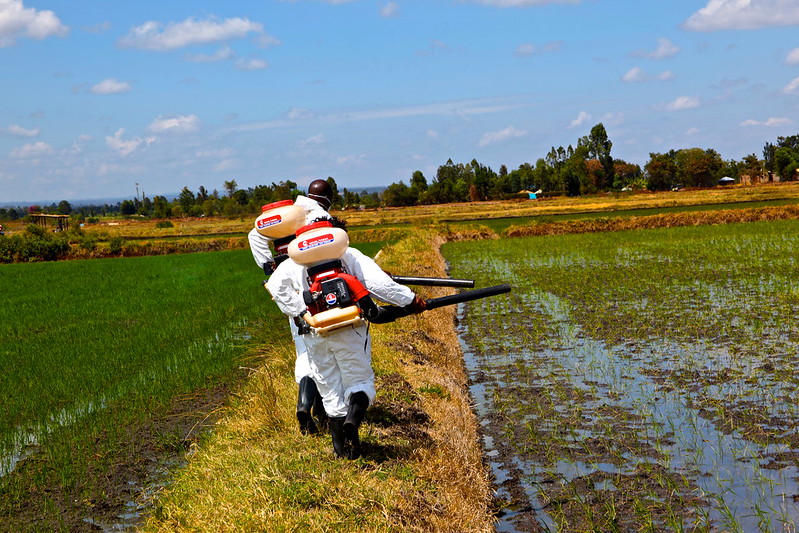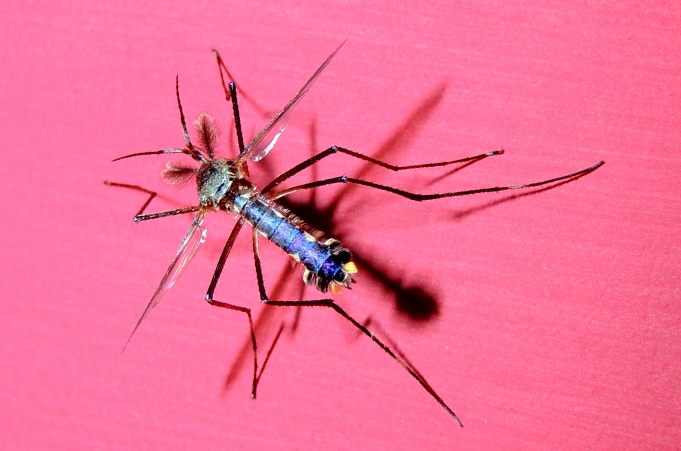News
Brazil: GMO insects to the rescue of Bt corn

After transgenic mosquitoes, Oxitec is disseminating transgenic larvae of Spodoptera frugiperda (OX5382G) on several thousand hectares in Brazil. This agricultural pest has become resistant to several chemical insecticides and to many transgenic Bt plants. Will the release of males with biased progeny circumvent these resistances?
Brazil is the second country, after the United States, in terms of area of transgenic plants cultivated. Soya, corn, cotton… mainly. Brazil is also the only country in the world to have authorized the commercial release of several transgenic insects. Mosquitoes in an attempt to control certain vector borne diseases in humans, such as dengue fever, with a widely demonstrated inefficiency. And insects that parasitize agricultural crops. For three years, genetically modified Spodoptera frugiperda larvae have been released in Bt corn fields in São Paulo and Mato Grosso.
Spodoptera frugiperda is a very important lepidopteran pest of corn, but also of millet, sorghum and cotton. It is widely present on the American continents and has started to establish itself in Africa since 2016. In an attempt to control its population, chemical insecticides have been sprayed. Result: this lepidopteran has evolved and is now globally resistant to these molecules. Bt corn and cotton, expressing several Cry proteins, have been grown to counter its resistance [1] In many countries, again, these insects have adapted, and have become resistant to most Cry proteins. The first response was to develop corn and cotton that produced multiple Cry proteins. This strategy provided some relief to farmers, but the cost of stacked gene seeds is also greater than first generation transgenic seeds. The new “solution” is to “sterilize” the insects themselves in an attempt to eradicate their population. The male sterile insect technique is not new. It has been used in Brazil on populations of mosquitoes Aedes aegyptii carrying the dengue virus. This new Oxitec dissemination project is carried out in partnership with Bayer, as the company states on its website. The CTNBio, the body in charge of GMO evaluation in Brazil, had already given its approval for a commercial use of Spodoptera frugiperdra in 2021.
A misleading communication
Oxitec’s press release does not state that this insect was genetically modified [2]. For its communication strategy, the company uses the same term as for the transgenic mosquito, namely “Friendly Fall Armyworn,” which could be translated as The “friendly” or “sympathetic” moth. In Brazil, the transgenic mosquito is called “Aedes do Bem” (the “good Aedes”) and in its Brazilian communication, Oxitec reiterates and speaks of “Spodotera do Bem” [3]. These adjectives , Oxitec explains, emphasize that these insects have been modified to fight diseases, pests. So Oxitec has modified nature to make it more palatable to humans. But we can also say that what is good is what allows to eradicate a population… Let’s add that Oxitec considers this adjective, “Friendly” or the expression “do Bem”, as its own brand. The company appropriates not only the living, but also the vocabulary that it hijacks to its advantage. And, in its desire to conceal reality, the press release indicates, in relation to this GMO, that it is a “biological pest control solution” or “new biological technology”. Beyond Oxitec’s press releases, which are often picked up as is by a few media outlets, no critical article – apart from one published in Wired in 2020 [4] – has deconstructed these releases.
GMO insects for GMO corn fields
Oxitec’s strategy is to combine the cultivation of Bt corn with releases of genetically modified insects so that the offspring are only male (thus implying some form of sterility). This combo had been implemented about ten years ago in the United States. In Arizona, the release of eleven billion cotton worms (Pectinophora gossypiella) rendered sterile by irradiation combined with the cultivation of Bt cotton and other practices has eliminated this pest [5]. But, unlike Spodoptera, Pectinophora is highly specific to cotton and is not native to this region (the first appearance of this worm was documented in the 1920s). Both of these elements were critical to the success of the eradication project.
Three years of releases and still not proven effective
The first experimental releases of these transgenic Spodoptera took place in the state of São Paulo, in 2020, in Bt corn fields, in small areas [6]. Armed with CTNBio’s authorization, the following year, trials also took place in the state of Mato Grosso, on thousands of hectares [7]. According to Natalia Ferreira, Director General of Oxitec in Brazil, interviewed by AgroPages, in 2021/ 2022, the releases were carried out on two farms, covering 8,800 hectares [8]. These releases were carried out in partnership with Lagoa Bonita Sementes in the state of Sao Paulo and with Fundação MT in the state of Mato Grosso [9]. When asked about the reduction of pesticides and the effectiveness in the fight against the pest that these releases have allowed, Natalia Ferreira, general manager of Oxitec Brazil, answers: “The pilot projects of this off-season were aimed at validating the effectiveness of the technology in the fight against the armyworm in different regions of Brazil. and to define the dosage per product and per hectare for different levels of infestation, as well as to enable the development and validation of distribution and shipping routes, and the development of new technologies to facilitate large-scale insect production. The impact of using the solution on integrated pest management and crop productivity is among the objectives of our subsequent pilot projects”. The company has yet to report the results of these trials. And the only scientific article that mentions this experiment, written by Oxitec and Bayer employees, is based on laboratory data and modeling [10]. However, curiously, the Oxitec website states that this insect “can fly up to 100 km per night and migrate 480 km before laying eggs, allowing them to spread rapidly to new areas”. Yet these data would argue for caution.
In 2023, Oxitec announces that the experimentation will be done on larger areas, without giving a precise figure [11]. Oxitec also gives no details on the number of insects released in the various trials. But full-scale commercialization is not envisioned until 2024 or 2025 [12].
Oxitec had previously conducted field trials with other agricultural pests. Most notably field trials in upstate New York in 2017 with the genetically modified diamondback moth [13]. Neil Morrison, in charge of these agricultural pests at Oxitec, stated in 2020 that “this project was completed and showed promising results, but the company decided to move on to the fall armyworm” [14] Inf’OGM has sought to understand why this project is no longer in the news, nor a number of others, to no avail. The only explanation is “that it is only a matter of time and resources”.
GMOs are not needed to control Spodoptera
The International Maize and Wheat Improvement Center (CIMMYT) has developed three maize hybrids that are “tolerant” to fall armyworm [15]
In its press release, CIMMYT states that “host plant resistance is an important component of integrated pest management (IPM). […] CIMMYT has worked intensively over the past three years to identify and validate sources of indigenous genetic resistance to fall armyworm in Africa. It has screened over 3,500 hybrids in 2018 and 2019.” Trials (under artificial infestation) were conducted in Kenya starting in 2017, and then in Tanzania. Now, CIMMYT, in conjunction with African national agricultural research organizations, is conducting national performance trials. The next step will be the dissemination and registration of these varieties. CIMMYT states on its website that “the hybrids will be sublicensed to partner seed companies on a non-exclusive, royalty-free basis to accelerate seed dissemination and deployment for the benefit of farming communities”.
This work was carried out with financial support from the CGIAR Maize Research Program (MAIZE), the U.S. Agency for International Development (USAID) Feed the Future initiative and the Bill & Melinda Gates Foundation.
[1] , « Les insectes résistent de plus en plus aux OGM insecticides », Inf’OGM, 24 June 2013, « Qu’est-ce que « l’acquisition de résistances » ? », Inf’OGM, 26 January 2015.
[2] Oxitec, press release, “Oxitec Completes First Farm-Scale Deployments of Friendly™ Fall Armyworm on Commercial Bt Corn in Brazil”], 14 March 2022.
[3] Oxitec, “Spodoptera do Bem™” or Oxitec, “Friendly™ Fall Armyworm”
[4] Niiler, E., [“Can a Genetically Modified Bug Combat a Global Farm Plague?”→https://www.wired.com/story/can-a-genetically-modified-bug-combat-a-global-farm-plague/], Wired, September 24, 2020.
[5] , « Les insectes OGM et stériles : une efficacité peu probante », Inf’OGM, 25 January 2023.
[6] Niiler, E., “Can a Genetically Modified Bug Combat a Global Farm Plague?”, Wired, 24 September 2020.
[7] Oxitec, press release, “Oxitec Completes Successful Season of Friendly™ Fall Armyworm Deployments on Large, Commercial-Scale Farms in Two Corn-growing Regions in Brazil”, 12 July 2022.
[8] Gottems, L., “Promising results with Friendly™ fall armyworm – Interview with Natalia Ferreira, Oxitec”, Agropages, 29 July 2022.
[9] Fundação MT is an important agricultural organization. It collaborates with agribusiness, such as BASF, Bayer or Syngenta
[10] Reavey, C.E., Walker, A.S., Joyce, S.P. et al., “Self-limiting fall armyworm: a new approach in development for sustainable crop protection and resistance management”, BMC Biotechnol 22, 5 (2022).
[11] Oxitec, press release, “Oxitec Launches New Scale-Up of Friendly™ Fall Armyworm Commercial-Scale Pilot Deployments on Large Farms in Brazil”, April 13, 2023.
[12] Gottems, L., “Promising results with Friendly™ fall armyworm – Interview with Natalia Ferreira, Oxitec”, Agropages, July 29, 2022.
[13] , « Les insectes OGM et stériles : une efficacité peu probante », Inf’OGM, 25 January 2023.
[14] Niiler, E., “Can a Genetically Modified Bug Combat a Global Farm Plague?”, Wired, September 24, 2020.
[15] CIMMYT, “Announcing CIMMYT-derived fall armyworm tolerant elite maize hybrids for eastern and southern Africa”, December 23, 2020.










